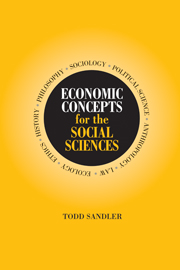Book contents
- Frontmatter
- Contents
- Table and Figures
- Preface
- 1 Economics without Apology
- 2 Back to the Future: Political Economy
- 3 In Another's Shoes: Games, Strategies, and Economics
- 4 It Takes Two or More: Public Economics and Collective Action
- 5 Government for the Politician? Public and Social Choice
- 6 Institutions Matter: The New Institutional Economics
- 7 Knowledge Is Power: Asymmetric Information
- 8 Everything Ties Together: General Equilibrium
- 9 Laboratory Economics: Of Rats and Men
- 10 Before Yesterday and Beyond Tomorrow: Intergenerational Economics
- 11 Fish, Space, and Spaceship Earth: Bioeconomics and Interdisciplinary Economics
- 12 Crystal Ball Economics: Rational Expectations
- 13 How Do We Get There from Here? Transition Economies and Policy Reforms
- 14 Economic Growth: Endogeneity, Institutions, and Other Concepts
- 15 Economic Visions of Future Horizons
- References
- Author Index
- Subject Index
14 - Economic Growth: Endogeneity, Institutions, and Other Concepts
Published online by Cambridge University Press: 14 May 2010
- Frontmatter
- Contents
- Table and Figures
- Preface
- 1 Economics without Apology
- 2 Back to the Future: Political Economy
- 3 In Another's Shoes: Games, Strategies, and Economics
- 4 It Takes Two or More: Public Economics and Collective Action
- 5 Government for the Politician? Public and Social Choice
- 6 Institutions Matter: The New Institutional Economics
- 7 Knowledge Is Power: Asymmetric Information
- 8 Everything Ties Together: General Equilibrium
- 9 Laboratory Economics: Of Rats and Men
- 10 Before Yesterday and Beyond Tomorrow: Intergenerational Economics
- 11 Fish, Space, and Spaceship Earth: Bioeconomics and Interdisciplinary Economics
- 12 Crystal Ball Economics: Rational Expectations
- 13 How Do We Get There from Here? Transition Economies and Policy Reforms
- 14 Economic Growth: Endogeneity, Institutions, and Other Concepts
- 15 Economic Visions of Future Horizons
- References
- Author Index
- Subject Index
Summary
Of the four basic economic problems – resource allocation, income distribution, stability, and growth – economists still have the most to learn about growth. If this were not the case, then it would be difficult to fathom why foreign aid has not been more successful in achieving sustained growth in less-developed countries (LDCs) over the last half century (World Bank 1998). Once the growth process is understood, it should be relatively easy to target aid to achieve the most sustained growth in recipient countries.
Throughout much of the last century, economic analysis has focused on static equilibria, which has done little to foster an understanding of economic growth, a process that requires a dynamic framework where the time path of variables are examined. There is no doubt that economist readers will disagree with my simple characterization of the profession's preoccupation, even obsession, with static models, and will point to an extensive neoclassical literature on growth associated with the analyses of Nobel laureates (for example, Tjalling Koopmans, Simon Kuznets, and Robert Solow) and others (for example, Trevor Swan, Roy Harrod, and Evsey Domar). This literature has enlightened us about some determinants of growth, but it does not adequately explain why some nations grow faster than others or how economic decisions determine a country's rate of growth. Most important, this earlier literature fails to account for the role of individual decisions and the influence of institutions on growth.
- Type
- Chapter
- Information
- Economic Concepts for the Social Sciences , pp. 229 - 243Publisher: Cambridge University PressPrint publication year: 2001



